
23.11.2019
By Cecília Floresta
Sesc 24 de Maio, São Paulo, Brasil
October 9, 2019 – February 2, 2020
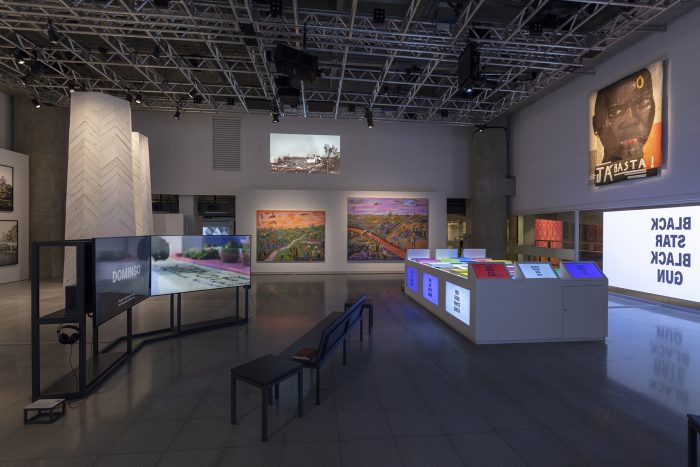
24 de Maio Street in the city of São Paulo is narrow as if it was a single tongue that reverberates it’s entire reflexive rambunctious through the pavement. A single tongue that branches into several, for in these surroundings that people who migrate are present, from remote places or the margins of the city. With tall buildings on both sides, on this street, there is almost no horizon. I think about how much a body that does not see horizons has to say, in comparison to how much a person that sees them ahead.
On one side of 24 de Maio Street, the imposing side façade of the Municipal Theater whose stairs house bodies that do not enter the interior. On the other side, a corner of Plaza de la República can be seen, and my eyes cannot fail to see the bodies that walk there; the Largo do Arouche extends circularly ahead. There are no horizons, but it may be possible to imagine them after all. That is what we glimpse at the 21st Sesc_Videobrasil Contemporary Art Biennial, with the curatorship of Gabriel Bogossian, Luisa Duarte and Miguel A. López, along with the 55 artists that comprise it: imaginary horizons
The title of the exhibition, Comunidades imaginadas [Imagined communities], opens many questions on the communal in terms of the way in which systems and institutions treat and make the subject visible. Firstly: what bodies are denied in the process of community creation, when for many, the community becomes essential every day for physical and symbolic survival? Aren’t communities, in addition to conjunctions, forced on some bodies as a means to separate them from spaces that a priori do not correspond to them? The sense of community has turned very disturbing when interpreted institutionally in different ways by different groups, in contrast to the reality of others whose communality lives under a concrete and constant threat. I mean, although community spaces do indeed dynamite a general white-hetero-cis-normalized idea of nation, some communities are usually placed in a stereotyped and minority scope as a way to contain, delegitimize or diminish them in terms of their importance.
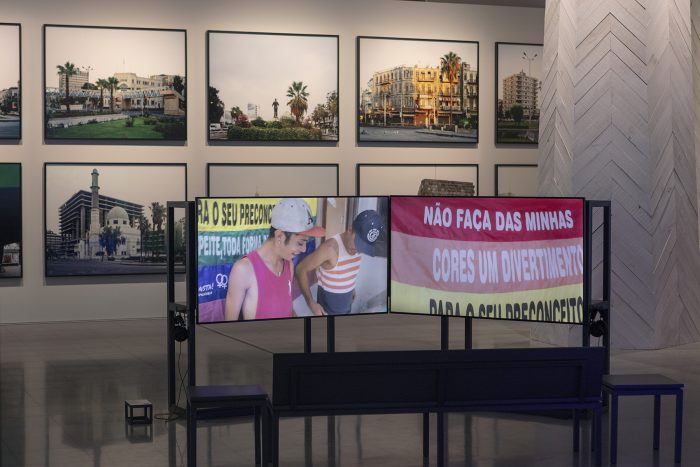
The community, for many people, responds to multiple possibilities: it sustains the individual inherent in us, gives volume to the voices to make themselves heard together, and allows sharing joys or setbacks that arouse resistance. That social communal tissue in the Videobrasil exhibition is portrayed in Domingo, by Paulo Mendel and Vitor Grunvald, a video-documentary that introduces us to the LGBTQIA+ Stronger collective, an emotional family created and formed by young people from the peripheries present in 50 cities in Brazil. This work reminds us that certain communities are seen as riots that, according to State officials, need to be pacified or dismantled, as if the community threatened an alleged order. What in fact occurs mainly when the community sees the possibility of autonomy, something we see in Voçoroca, a project by the #VoteLGBT collective. It is precisely that pursue for autonomy within the community that suggests that traffic on the margins can often be directed to the center without necessarily escaping through the gaps, jumping real or imaginary walls that the state of things does not stop lifting.
The memory of the registered objects was something strongly captured in my journey through the exhibition. My steps were carried by the gaze that settled on one of the collections that compose it, Joias africanas, which, together with the symbolic dimensions of André Griffo, brought to light the memory of the metal, so painful for some, remembering the forced dissolutions of freedom and the tools of enslaved cultivation of an alien land, when in memory they could be valuable and delicate artifacts, endowed with ancestrality and identity. Next, Natalia Skobeeva’s Biographies of Objects video, whose disposition invites a zenith perspective, illustrates in verbal and iconographic profusions how objects contain identities and how narratives focus on the pieces that make up the imaginary and collective knowledge that survives time, representing what belongs to us as a mirror in which we see ourselves, when we have mirrors within reach.
Further on, Claudia Martínez Garay molds de memory of clay, it evokes the ancestral wisdom that indicates that we are made of the same clay that will swallow us, also remembering that regardless of thoughts about life and death, objects perdure as vestiges that reflect those circular reflections. Cycles likewise are remembered by the video installation What is left of the sugar cubes? by Thierry Oussou, in which sugar emerges in historical and socioeconomic meanings, to reaffirm the maxim that indicates that people without memory is not a nation, and how said memory, is conditioned by the loss and gain of institutions that decide what to keep as heritage or simply destroy.
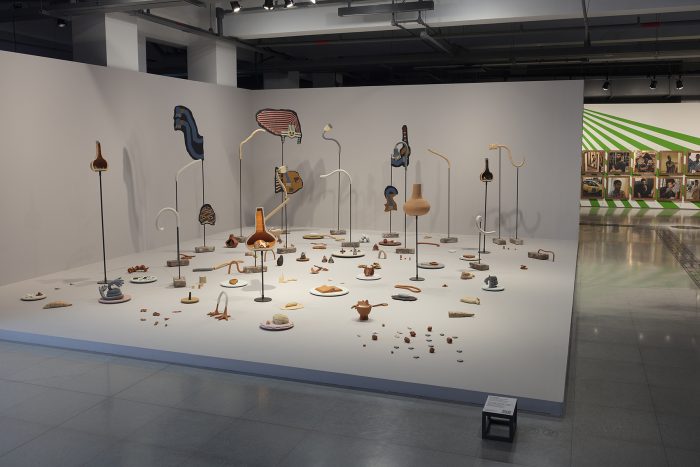
If objects are stored as material memory, the boundaries that unite and separate identity narratives are imaginary and mobile. An example of this instability would be Procurando Jesus [Procuring Jesus], an installation by Jonathas de Andrade who photographed faces of men in Jordan whose features could belong to a Jesus devoid of a white imaginary. The work is accompanied by a series of testimonies of which one of them summarizes the border idea linked to the meanings recorded here: “At that time there were no borders. If you want to choose Jesus today, he will have to come from somewhere. That’s the problem.»
The place where we come from matters and the spaces where we are allowed to travel depend on it. Then, we can say that for some there are very well defined boundaries by whoever owns the chalk, the one who draws and erases the lines that constrict—a reflection that makes it possible to materially revisit the performance of Marton Robinson. However, perhaps these borders can also be dissolved by the encounter, when a desire for proximity exists, as in the photographs of Georges Senga, a true game with those mirrors, which, in an image of distance and approach between the urban territory of the Democratic Republic of the Congo and Brazil, shows, in the course of the eyes, places that mix—almost do not differ in the awakening of memory—perhaps only by movement, idiomatic signs, objects.
Still located in a dialogue in the borders, my perception drew a line, very common by the way, in the exhibition space that almost delimited a place for bodies and voices whose desire goes far beyond the lines of possession, towards the sacred and total territory condition. I understand the depth that can be reached at the confluence, but I wonder if the stories cannot be rethought, pluralized. In the show, there are several approaches to original peoples, of course, but by arranging them in a supposed union or unique community, I perceived, would it not also erase their particularities? The unity of force is necessary, but I think that establishing it in formal spaces can also lead to an identity planning movement, where dialogue and contrasts are lost.
In dialogue with the sewing of memories, the words of Patrice Lumumba in E’ville, by Nelson Makengo, who, taking the images’ background that record the ruins of the present, remember how the decolonial is absorbed into our bodies, mouths, and letters for longer than we usually remember. Weaving these memories into beads, Tela bordada [Embroidered Cloth], an action conceived by Teresa Margolles, proposes a work achieved by women in a cloth from the morgue while telling their stories, contrasting an object with remains of death and violence with the life contained in the narratives. Even in this sense, Luiz de Abreu brings back the memory of the political body that dances, but in which, profoundly stereotyped deep marks also appear.
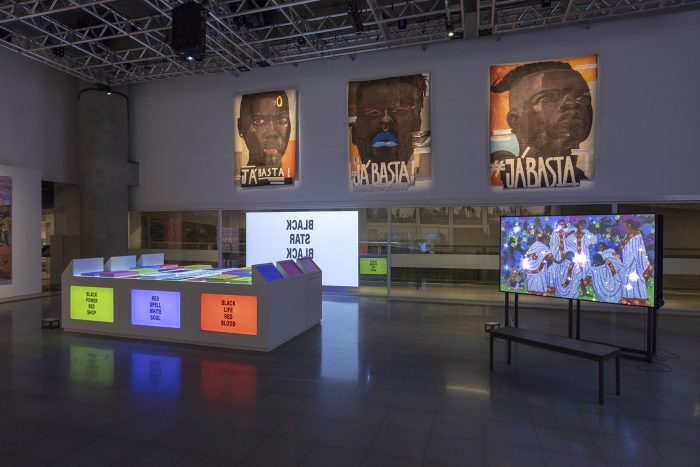
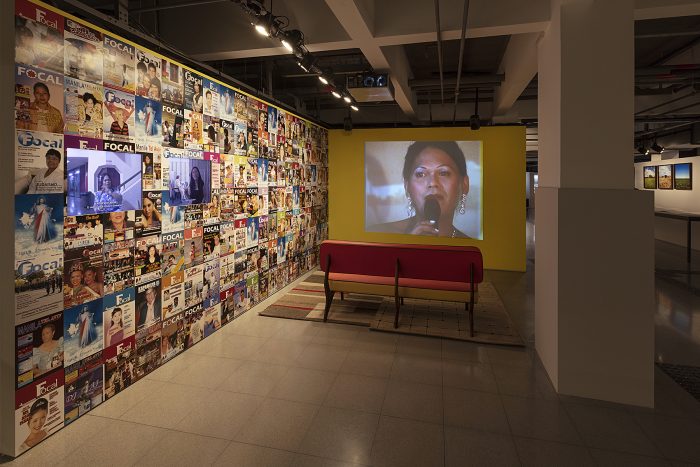
What unites and also separates can be done in several ways as long as there is no disparity between heights. That was what I thought when I looked into the space that my feet declared the last (or first?) of the exhibition, and I found myself in front of the video of Mohau Modisakeng, which captures movements in a loop whose impression is of incompleteness and recurring expectation, evoking in acts and words, a Tsuana proverb present in the title of the work that says: Phiri o rile ga bose gangwe, which translates: «The hyena spoke: the dawn does not come once.» On the other side of the space, I found Nidhal Chamekh’s Never Give Up, which records an act of autonomous resistance by refugee groups whose camp was attacked, so they are forced to leave their community, setting fire to their improvised homes before others did. In the middle of the consumption of fire, we see the inscription «Never give up» resonating in the same renewal element of the movement in the eternal break of dawn.
Another tangible topic in the biennial is the forced disputes or divisions of territories, which we see juxtaposed in Tomaz Klotzel’s installation. Likewise, No Martins allows us to glimpse territorial disputes even in words, in its series of portraits that recover newspapers headlines loaded with stereotypes, denouncing, through the work, the violence and media barriers that represent racialized people, in a dialogue with Emo de Medeiros and his device that brought to light subconscious apartheids that emerge in the naturalization of a language that imposes damage through both automatic and well-designed racialization mechanisms.
The almost labyrinthine circular movement, proposed by the exhibition’s museology and culminating in imaginary dialogues between the works, also occupied other spaces of Sesc 24 de Maio, without pointing to answers, but to possibilities of creation in multiple horizons delineated by these approaches and distances that presuppose community creation or community disposition. The conjugation of the expressivities, which overflow the possible interconnections, occurred in the exhibition with a proposal that seeks to extrapolate even the dialectic, often found diminished and set aside in exhibition spaces. Thus, put together, the works enabled imagined communities in infinite combinations, mainly causing tensions of palpable order that exceed the walls of the building.
Comentarios
No hay comentarios disponibles.